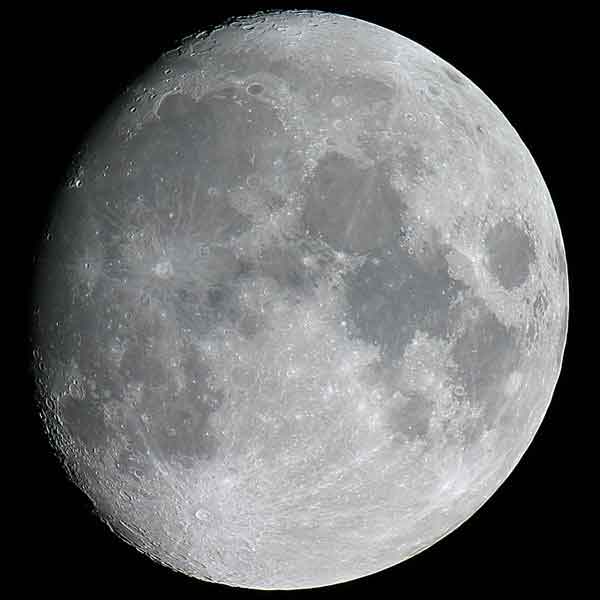 |
usa | world | animals | vocabulary | health | science | math | history |
The Moon

The Moon is the planet Earth's only natural satellite. It has no formal name other than "The Moon", although it is occasionally called Luna (Latin for moon), or Selene, to distinguish it from the generic "moon" (natural satellites of other planets are also called moons). Its symbol is a crescent. The terms lunar, selene/seleno-, and cynthion (from the Lunar deities Selene and Cynthia) refer to the Moon (aposelene, selenocentric, pericynthion, etc.).
The average distance from the Moon to the Earth is 384,403 kilometers (238,857 miles). The Moon's diameter is 3,476 kilometers (2,160 miles).
The first manmade object to land on the Moon was Luna 2 in 1959, the first photographs of the otherwise occluded far side of the Moon were made by Luna 3 that same year, and the first people to land on the Moon came aboard Apollo 11 in 1969.
The far side is sometimes called the "dark side". In this case "dark" means "unknown and hidden" and not "lacking light" as percieved by the name; in fact the far side receives (on average) as much sunlight as the near side, but at opposite times. Spacecraft are cut off from direct radio communication with the Earth when on the far side of the Moon.
One distinguishing feature of the far side is its almost complete lack of maria, which are the dark albedo features.
The Moon makes a complete orbit about once every 28 days. Each hour the Moon moves relative to the stars by an amount roughly equal to its angular diameter, or by about 0.5°. The Moon differs from most satellites of other planets in that its orbit is close to the plane of the ecliptic and not in the Earth's equatorial plane.
The tides on Earth are generated by the Moon's gravitation. There are two tidal bulges, one in the direction of the Moon, and one in the opposite direction. The buildup of these bulges and their movement around the earth causes an energy loss due to friction. The energy loss decreases the rotational energy of the Earth.
Since the Earth spins faster than the Moon moves around it, the tidal bulges are dragged along with the Earth's surface faster than the Moon moves, and move "in front of the Moon". Because of this, the Earth's gravitational pull on the Moon has a component in the Moon's "forward" direction with respect to its orbit. This component of the gravitational forces between the two bodies acts like a torque on the Earth's rotation, and transfers angular momentum and rotational energy from the Earth's spin to the Moon's orbital movement.
The inclination of the Moon's orbit makes it implausible that the Moon formed along with the Earth or was captured later; its origin is the subject of some scientific debate.
Early speculation proposed that the Moon broke off from the Earth's crust due to centrifugal force, leaving an ocean basin (presumed to be the Pacific) behind as a scar. This concept requires too great an initial spin of the Earth. Others speculated the Moon formed elsewhere and was captured into its orbit. Two of the other theories include the coformation or condensation theory and the impact theory, which speculates that the Moon formed from the debris that resulted from a collision between the early Earth and a planetesimal.
The Coformation or Condensation hypothesis posits that the Earth and the Moon formed together at about the same time from the primordial accretion disk, the Moon forming from material surrounding the coalescing proto-Earth, similar to the way the planets formed around the Sun. Some suggest that this hypothesis fails to adequately explain the depletion of iron in the Moon.
Recently, the Giant Impact theory has been considered a more viable scientific theory for the moon's origin than the coformation or condensation theory. The Giant Impact theory holds that the Moon formed from the ejecta resulting from a collision between a semi-molten Earth and a planet-like object the size of Mars, which has been referred to as Theia.
This article is licensed under the GNU Free Documentation License. It uses material from the Wikipedia article "moon".